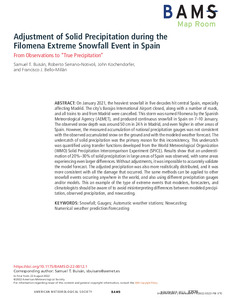Por favor, use este identificador para citar o enlazar este ítem:
http://hdl.handle.net/20.500.11765/14173
Adjustment of solid precipitation during the Filomena extreme snowfall event in Spain: from observations to “true precipitation”
| Título : | Adjustment of solid precipitation during the Filomena extreme snowfall event in Spain: from observations to “true precipitation” |
| Autor : | Buisán Sanz, Samuel Tomás






|
| Palabras clave : | Snowfall; Gauges; Automatic weather stations; Nowcasting; Numerical weather prediction; Numerical weather forecasting |
| Fecha de publicación : | 2022 |
| Editor: | American Meteorological Society |
| Citación : | Bulletin of the American Meteorological Society. 2022, 103(11), p. E2570–E2578 |
| Versión del editor: | https://doi.org/10.1175/BAMS-D-22-0012.1 |
| Resumen : | On January 2021, the heaviest snowfall in five decades hit central Spain, especially affecting Madrid. The city’s Barajas International Airport closed, along with a number of roads, and all trains to and from Madrid were cancelled. This storm was named Filomena by the Spanish Meteorological Agency (AEMET), and produced continuous snowfall in Spain on 7–10 January. The observed snow depth was around 50 cm in 24 h in Madrid, and even higher in other areas of Spain. However, the measured accumulation of national precipitation gauges was not consistent with the observed accumulated snow on the ground and with the modeled weather forecast. The undercatch of solid precipitation was the primary reason for this inconsistency. This undercatch was quantified using transfer functions developed from the World Meteorological Organization (WMO) Solid Precipitation Intercomparison Experiment (SPICE). Results show that an underestimation of 20%–30% of solid precipitation in large areas of Spain was observed, with some areas experiencing even larger differences. Without adjustments, it was impossible to accurately validate the model forecast. The adjusted precipitation was also more realistically distributed, and it was more consistent with all the damage that occurred. The same methods can be applied to other snowfall events occurring anywhere in the world, and also using different precipitation gauges and/or models. This an example of the type of extreme events that modelers, forecasters, and climatologists should be aware of to avoid misinterpreting differences between modeled precipitation, observed precipitation, and nowcasting. |
| URI : | http://hdl.handle.net/20.500.11765/14173 |
| ISSN : | 0003-0007 1520-0477 |
| Colecciones: | Artículos científicos 2019-2022 |
Ficheros en este ítem:
| Fichero | Descripción | Tamaño | Formato | ||
|---|---|---|---|---|---|
| 1520-0477-BAMS-D-22-0... | 2,37 MB | Adobe PDF |  Visualizar/Abrir |
Los ítems de Arcimis están protegidos por una Licencia Creative Commons, salvo que se indique lo contrario.





